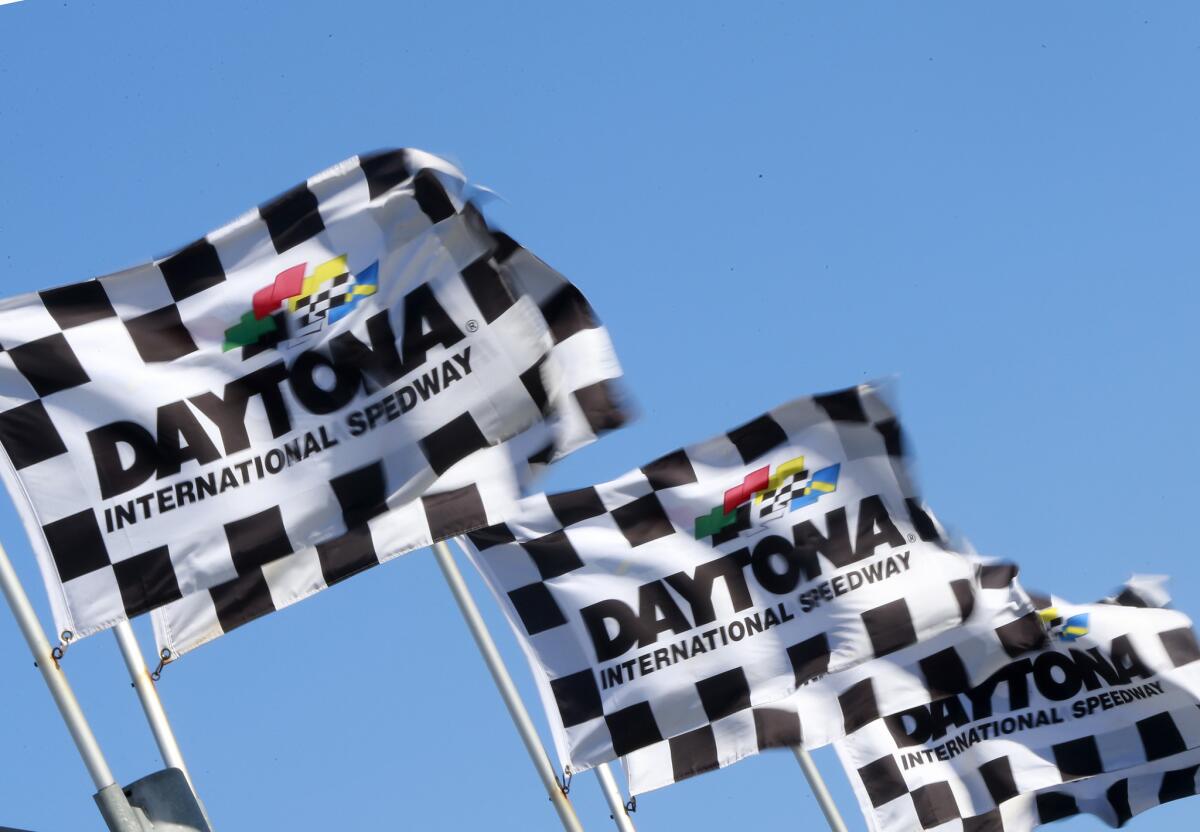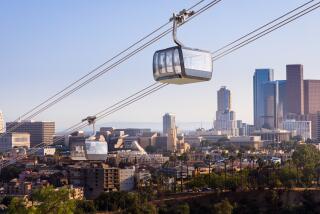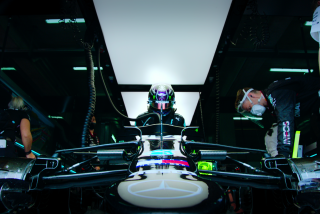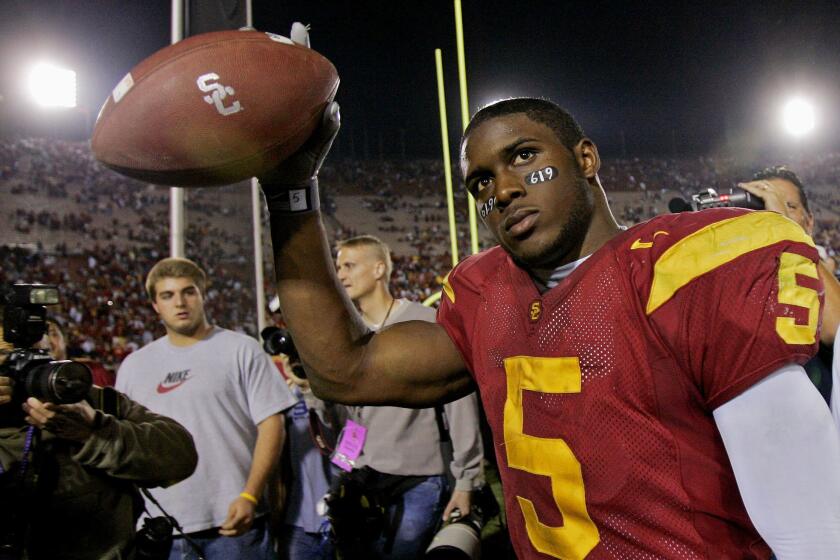Daytona International Speedway undergoes a major facelift aimed at attracting more customers

Daytona International Speedyway flags fly during practice for the NASCAR Sprint Cup Series Daytona 500 on Feb. 13.
“Daytona Rising” is a counterintuitive concept in a motor-sports business model struggling to put fannies in seats.
Go Big. Go Bold.
NASCAR spectators entering one of the most iconic venues in motor sports during Speedweeks are likely to be impressed with the makeover of a track that welcomed its first customers in 1959. Now, the fancy fixer-upper includes huge concourses with interactive displays, 1,400 television screens, 60 suites, 40 escalators and 17 elevators, and a nose-cone replica of a space shuttle.
The tab came to $400 million. The hope is that 101,500 spectators will fill the joint and leave enthralled by the experience.
“You want to make the property, for lack of a better word, feel comfortable,” said Joie Chitwood III, president of Daytona International Speedway. “A place where you can walk around and look at stuff and say, ‘Oh, that’s interesting,’ and you keep walking and look around the corner and see something else that’s interesting.”
There is a lot of “stuff” to see here, from the replica of the space shuttle at the Toyota injector that also includes race cars dangling over customers’ heads, a waterfall at the Florida Hospital injector and the Daytona 500 winner’s trophy at a sports bar called Harley J’s.
“Injector” is a fancy new word in the NASCAR vocabulary. Think huge concourse, interactive breezeway areas. There are five of those, including four partners — Florida Hospital, Sunoco, Chevrolet and Toyota — providing expansive entryways into the sports stadium that spans nine-tenths of a mile.
That is correct. It’s a racetrack. And a sports stadium. That’s exactly what the blueprint calls for, getting back to the original premise: Big and bold.
The bold phase of this project is set against a challenging economic backdrop. Although NASCAR does not release attendance numbers for races, the anecdotal evidence is obvious: Lots of empty seats lately. Multiple tracks, including Talladega, Atlanta and Charlotte, have reduced their seating capacity. Charlotte took out 41,000 seats.
Chitwood and the folks at International Speedway Corporation, which owns the property, looked at the landscape and went for the proverbial home run. Build a place with a wow factor that will get people out of their homes and the cozy comforts of their flat-screen TVs and well-stocked fridge.
“I’ve got to make sure that Daytona can command that investment, that it’s worth their time and hard-earned dollars to come to Daytona,” Chitwood said.
The renovated facility is expected to attract concerts and other sporting events, including a country-music festival featuring Willie Nelson, Kid Rock, Luke Bryan and Jennifer Nettles, among others, that has been booked for Memorial Day weekend. About 250 events are staged here yearly, but the primary focus obviously is racing. Fans gave the project a big thumbs-up during a test run over the Rolex 24 weekend, but now comes the bigger challenge: Keeping everyone happy during Speedweeks, leading to the Daytona 500 on Feb. 21.
Daytona actually has been downsized. Don’t look for the backstretch grandstand between Turns 2 and 3. It is gone, along with 44,000 seats. That was always poor man’s corner anyway. The good stuff — start and finish — is where the action is, and now the entire focus of the fan experience.
The price point may be out of your budget range. Loge boxes, which seat up to 12 people, cost between $16,000 and $24,000. Access to Harley J’s is between $2,200 and $2,300 per person. But it’s all about the perks: Great sight lines, comfortable seating (21 inches wide), opportunities for a corporate wine-and-dine and covered concourses that will allow fans to remain comfortable in case of inclement weather.
There will be no more hospitality tents outside the property, the place where race-week high rollers traditionally came for prime amenities and meet-and-greets with drivers and celebrities.
“You walk through this space and think about Astroturf, tents and white picket fence versus this,” Chitwood said. “Modern, new, progressive attention to detail, permanent restrooms. If you are going to entertain at Daytona, and you’re going to bring executives with you, you are going to do it the right way.”
Daytona Rising is tearing up the old places as well as tearing up the stereotypes of a sweaty, grimy race-day experience where your best food option was a hot dog and chips. Now, you can have a choice of menu items that include shrimp scampi, carved prime rib, and — wait for it — a veggie burger.
“It’s an incredible project, and just the amount of money spent and thought and detail put into it, it really changes the game on what people are going to expect when they come to the racetrack now,” said Martin Truex Jr., a final-four participant in last year’s Chase for the Championship. “From the fans’ perspective, it’s really the first motor-sports stadium that we’re going to and definitely raised the bar. Fans are going to love it.”
They also will be safer. Keeping fans out of harm’s way has been imperative, and challenging, for a sport that involves machines that can swerve out of control going close to 200 mph. The most serious incident in recent years came in February 2013, when Kyle Larson’s car flew into the grandstand along the track’s frontstretch during a Nationwide (now Xfinity) Series race. The multicar accident left an estimated 32 people injured.
Safety improvements began immediately, including reinforcing eight crossover gates and fencing along the 2.5-mile tri-oval. The Daytona Rising project takes it to another level. The frontstretch grandstands have been elevated and moved back, and access along “rim road” will be restricted to pre-race events.
“I haven’t had a chance to catch a breath,” Chitwood said. “We’re so focused on making sure that our fans have a great experience. We’ve worked so many years to bring this property to life. Now we have to get through these events. I’m hoping by Feb. 22, I can catch my breath.”
More to Read
Get our high school sports newsletter
Prep Rally is devoted to the SoCal high school sports experience, bringing you scores, stories and a behind-the-scenes look at what makes prep sports so popular.
You may occasionally receive promotional content from the Los Angeles Times.






